Richard L. Daft - Management. 9th ed., 2010
Подождите немного. Документ загружается.


PART 6 CONTROLLING580
Recall the analogy of the rocks and the water. To reduce inventory levels to zero
means that all management and coordination problems will surface and must be
resolved. Scheduling must be scrupulously precise and logistics tightly coordinated.
For example, follow the movement of a shipment of odometers and speedometers
from a supplier in Winchester, Virginia, to the Nissan plant in Canton, Mississippi.
Thursday, 9 a.m.: A truck arrives at the supplier. As workers load the parts, driv-
ers check on-board computers for destination, route, and esti-
mated time of arrival (ETA) data.
Friday, 3 a.m.: The truck arrives at Canton, Mississippi, and approaches a switch-
ing yard two miles from the Nissan plant, parking in a computer-
assigned spot. The driver downloads a key-shaped oppy disk
from the on-board computer into the trucking company’s main-
frame, which relays the performance report directly to Nissan.
Friday, 12:50 p.m.: The trailer leaves the switching yard at a designated time and
arrives at a predetermined receiving dock at the Nissan plant,
where workers unload the parts and send them to the produc-
tion line just in time.
29
The coordination required by JIT demands that information be shared among
everyone in the supply chain. Communication between only adjoining links in the
supply chain is too slow. Rather, coordination requires a kind of information web in
which members of the supply chain share information simultaneously with all other
participants, often using Internet technologies and perhaps RFID.
30
INFORMATION TECHNOLOGY HAS TRANSFORMED
MANAGEMENT
Advanced information technology makes just-in-time inventory management work
seamlessly, but it has also transformed management in many other ways. An organiza-
tion’s information technology (IT) consists of the hardware, software, telecommunica-
tions, database management, and other technologies it uses to store data and make them
available in the form of information for organizational decision making. In general,
information technology has positive implications for the practice of management.
Boundaries Dissolve; Collaboration Reigns
Walk into the video conference room at Infosys Technologies, a leader in India’s out-
sourcing and software industry, and the rst thing you’ll see is a wall-size at-screen
television. On that screen, Infosys can hold virtual meetings of the key players from
its entire global supply chain for any project at any time of the day or night.
31
Time, distance, and other boundaries between individuals, departments, and
organizations are irrelevant in today’s business world. Collaboration is what it’s all
about. Information technology can connect people around the world for the shar-
ing and exchange of information and ideas. As historian Thomas L. Friedman puts
it, “Wherever you look today . . . hierarchies are being attened and value is being
created less and less within vertical silos and more and more through horizontal col-
laboration within companies, between companies, and among individuals.”
32
Knowledge Management
Information technology plays a key role in managers’ efforts to support and leverage
organizational knowledge. Knowledge management refers to the efforts to system-
atically gather knowledge, organize it, make it widely available throughout the orga-
nization, and foster a culture of continuous learning and knowledge sharing.
33
i
i
i
i
in
in
inf
ormation technolo
gy
(
IT)
)
)
)
)
T
T
T
T
T
h
e
T
T
T
h
ar
d
ware
,
s
,
o
f
tware
,
,
t
t
t
e
l
t
e
el
t
t
e
el
eco
eco
mmu
mmu
i
nic
nic
ti
ati
ati
ons
ons
d
,d
,
d
t
ata
ata
b
bas
bas
e
e
m
m
m
m
m
m
ana
g
ement, and other tech-
n
n
n
n
n
olo
g
ies used to store, process
,
,
a
a
a
a
an
nd
d
i
st
ri
bute
inf
o
rm
at
i
o
n
.
k
k
k
k
k
nowled
g
e mana
g
ement
T
T
T
T
T
he process of systematically
g
g
g
g
ga
a
thering knowledge, makin
g
i
i
it
t
t
t
widel
y
available throu
g
hout
t
t
t
h
h
h
e or
g
anization, and fosterin
g
g
a
a
a
a
a
culture of learnin
g
.
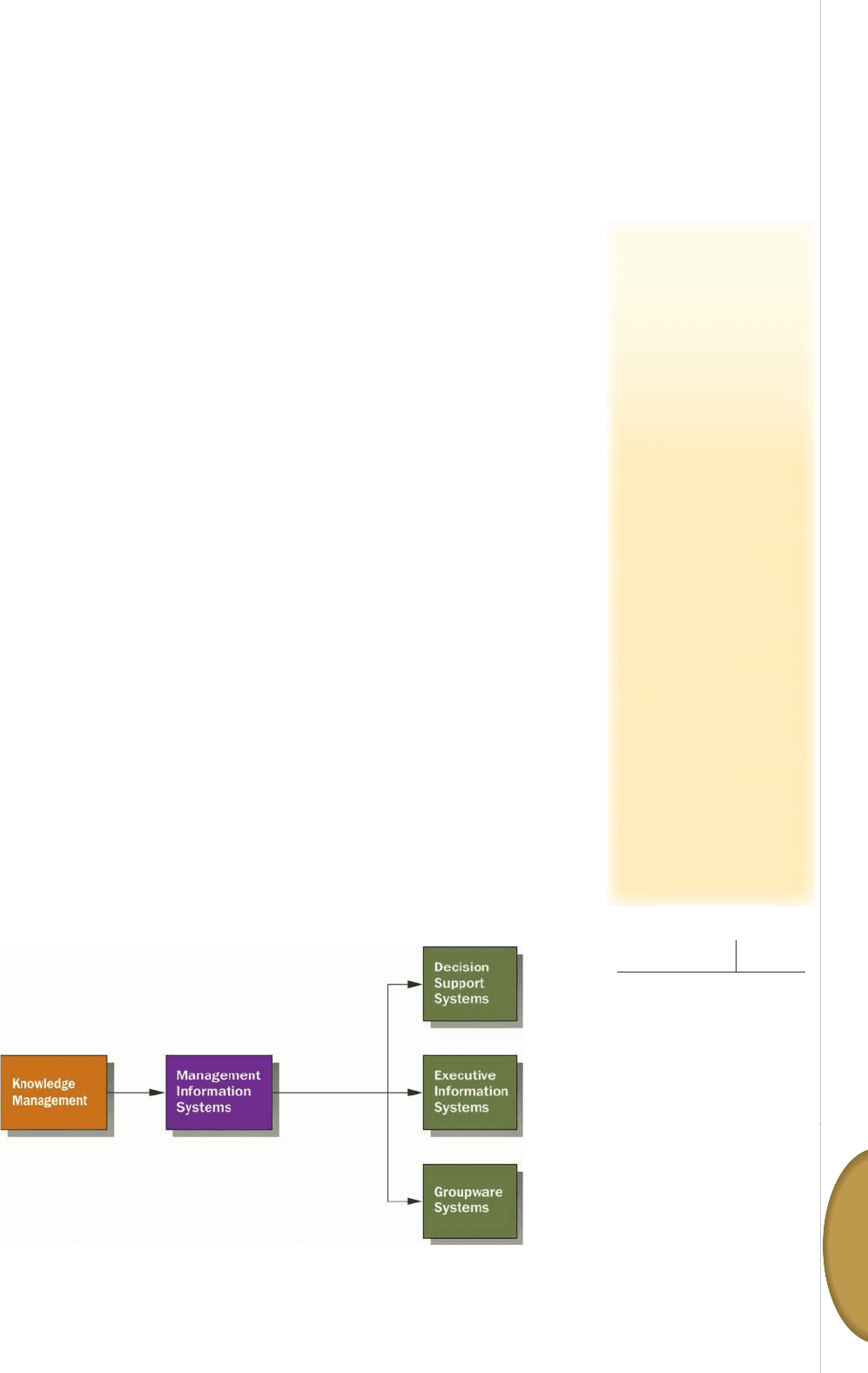
CHAPTER 19 MANAGING THE VALUE CHAIN, INFORMATION TECHNOLOGY, AND E-BUSINESS 581
Controlling
6
Knowledge is not the same thing as data or information, although it uses both.
Data are simple, absolute facts and gures that, in and of themselves, may be of little
use. A company might have data that show 30 percent of a particular product is sold
to customers in Florida. To be useful to the organization, the data are processed into
nished information by connecting them with other data—for example, nine out of ten
of the products sold in Florida are bought by people over the age of sixty. Information
is data that have been linked with other data and converted into a useful context
for speci c use. Knowledge goes a step further; it is a conclusion drawn from the
information after it is linked to other information and compared to what is already
known. Knowledge, as opposed to information and data, always has a human factor.
Books can contain information, but the information becomes knowledge only when
a person absorbs it and puts it to use.
34
IT systems facilitate knowledge management by enabling organizations to collect
and store tremendous amounts of data, analyze that data so it can be transformed
into information and knowledge, and share knowledge all across the enterprise. The
most common organizational approach to knowledge management is sharing knowl-
edge via information technology.
35
A variety of new software tools support collabora-
tion and knowledge sharing through services such as Web conferencing, knowledge
portals, content management, and the use of wikis. A knowledge management portal
is a single, personalized point of access for employees to multiple sources of informa-
tion on the corporate intranet. A wiki uses software to create a Web site that allows
anyone with access to create, share, and edit content through a simple brower-based
user interface. Organizations typically use a variety of IT systems to facilitate the col-
lection, analysis, and sharing of information and knowledge.
Another IT application for knowledge management is the use of business
intelligence software that analyzes data and extracts useful insights, patterns, and
relationships that might be signi cant.
36
The application of business intelligence soft-
ware at Cendant Hotel Group lets managers know immediately when a huge surge
of interest in triple rooms in San Diego or Phoenix happens, enabling the company to
add inventory or adjust offerings on its Web site. Similarly, managers in other rms
can identify sets of products that particular market segments purchase, patterns of
transactions that signal possible fraud, or patterns of product performance that may
indicate defects.
Management Information Systems
A management information system (MIS) is a computer-based system that provides
information and support for effective managerial decision making. The central ele-
ments of a management information system are illustrated in Exhibit 19.6.
EXHIBIT 19.6
Basic Elements of Manage-
ment Information Systems
SOURCE: Adapted from Ralph M. Stair and George W. Reynolds, Principles of Information Systems: A
Managerial Approach, 4th ed. (Cambridge, MA: Course Technology, 1999), p. 391.
d
d
d
d
d
dat
a
Raw, unsummarized, an
d
d
d
d
d
u
u
u
u
u
u
nanal
y
zed facts and fi
g
ures
.
i
i
i
i
i
n
f
ormation
D
ata t
h
at
h
ave
b
b
b
b
b
ee
b
n converte
d
into a mean-
i
i
in
n
n
gful and useful context for
t
t
t
h
h
e receiver.
k
k
k
k
k
now
l
e
dg
e
A
conc
l
usion
d
d
d
d
d
d
ra
d
wn
f
rom in
f
ormation a
f
ter
i
i
it
t
t
t
t
is
is
lin
lin
ked
ked
to
to
ot
ot
her
her
in
in
for
for
ma
ma
-
t
t
t
t
i
i
o
t
n and com
p
ared to what is
a
a
a
al
l
al
l
r
a
d
ea
d
k
y
k
nown.
k
k
k
k
k
now
l
e
dg
e mana
g
ement
p
p
p
p
p
orta
l
A
sing
l
e point o
f
ac
-
c
c
c
c
ce
e
ss
f
or emp
l
oyees to mu
l
tip
l
e
s
s
s
s
so
o
urces of information that
p
p
p
p
p
rovides
p
ersonalized access o
n
n
n
n
n
n
t
t
t
h
h
h
e cor
p
orate intranet
.
w
w
w
w
w
i
k
i We
b
site t
h
at a
ll
ows
a
a
a
a
an
n
yone wit
h
access, insi
d
e or
o
o
o
o
o
utside the organization, to
c
c
c
c
cr
r
eate, share, and edit content
t
t
t
h
h
h
rou
g
h a simple, browser-
b
b
b
b
b
as
ed
use
r in
te
rf
a
ce
.
b
b
b
b
b
usiness inte
ll
i
g
ence so
f
t-
w
w
w
w
war
e
software that analyzes
d
d
d
d
d
d
ata from multi
p
le sources
a
a
a
a
an
n
d extracts useful insi
g
hts,
p
p
p
p
p
atterns, and relationships tha
t
t
m
m
m
m
m
m
i
g
ht be si
g
nifi cant.
m
m
m
m
m
anagement information
s
s
s
s
s
ystem
(
MIS
)
A
com
p
uter
-
b
b
b
b
b
ased s
y
stem that provides
i
i
in
n
n
n
formation and support for
e
e
e
e
ef
f
fective mana
g
erial decision
m
m
m
m
m
mak
mak
m
m
in
g
g
.

PART 6 CONTROLLING582
MISs typically support strategic decision-making needs of mid-level and top man-
agement. However, as technology becomes more widely accessible, more employees
are wired into networks, and organizations push decision making downward in the
hierarchy, these kinds of systems are seeing use at all levels of the organization. For
example, when a production supervisor needs to make a decision about produc-
tion scheduling, he or she may need data on the anticipated number of orders in the
coming month, inventory levels, and availability of computers and personnel. The
MIS can provide these data. At Veterans Administration (VA) hospitals around the
country, a sophisticated MIS called Vista enables people all across the organization
to access complete patient information and provide better care. The VA, once con-
sidered subpar, has been transformed by technology into one of the highest-quality,
most cost-effective medical providers in the United States.
37
Management information systems typically include decision support systems,
executive information systems, and groupware.
Decision support systems (DSSs) are interactive, computer-based information
systems that rely on decision models and specialized databases to support decision
makers. With electronic spreadsheets and other decision support software, users can
pose a series of what-if questions to test alternatives they are considering. Based on
the assumptions used in the software or speci ed by the user, managers can explore
various alternatives and receive tentative information to help them choose the alter-
native with the best outcome. Big retailers such as Home Depot, Bloomingdale’s, and
Gap use decision support systems to help them gauge when to mark down prices
and what items to discount, for example.
38
Executive information systems (EISs) are management information systems to facil-
itate strategic decision making at the highest level of management. These systems are
typically based on software that provides easy access to large amounts of complex data
and can analyze and present information in a timely fashion. EISs provide top manage-
ment with quick access to relevant internal and external information and, if designed
properly, can help them diagnose problems as well as develop solutions. Many compa-
nies use executive information systems that enable top managers to view a dashboard of
key performance indicators on their PCs or laptops. A business performance dashboard
uses software to present key business information (e.g., sales data, ll rates for orders,
or pro ts per product line) in graphical, easy-to-interpret form and can alert managers
to any deviations or unusual patterns in the data. Dashboards pull data from a variety
of organizational systems and databases, gauge the data against key performance met-
rics, and pull out the right nuggets of information to deliver
to top managers for analysis and action.
39
The effective use of
business performance dashboards is further discussed in this
chapter’s Manager’s Shoptalk.
Modern information technology systems also recognize
that many organizational and managerial activities involve
groups of people working together to solve problems and
meet customer needs. Groupware is software that works
on a computer network or via the Internet to link people or
workgroups across a room or around the globe. The software
enables managers or team members to communicate, share
information, and work simultaneously on the same docu-
ment, chart, or diagram and see changes and comments as
they are made by others. Sometimes called collaborative work
systems, groupware systems allow people to interact with
one another in an electronic meeting space and at the same
time take advantage of computer-based support data.
Enterprise Resource Planning Systems
Another key IT component for many companies is an ap proach
to information management called enterprise resource plan-
ning.
Enterprise resource planning (ERP) systems integrate
Alliance Steel Services increased
revenues by 500 percent in three years after CEO Michael
Zweigbaum invested in a computer inventory management
system. This family-run scrap metal business went from
pen and paper management to a computerized system that
captures each scrap delivery with a photo, weight, and grade.
Zweigbaum uses a business performance dashboard to moni-
tor how often and how effi ciently the inventory moves. He cred-
its the management system’s precision for enabling Alliance to
sell more brass, copper, and titanium to developing countries,
which increased profi ts.
© THOMAS STRAND
d
d
d
d
d
dec
ision support s
y
stem
(
(
(
(DS
S
)
A
n interactive,
c
c
c
co
o
m
c
c
p
ut
p
er-based s
y
s
y
tem that
u
u
u
u
u
se
u
u
se
u
sd
s
d
eci
eci
sio
sio
nm
n
m
ode
ode
ls
ls
and
and
sp
sp
e-
e-
c
c
c
c
ci
i
alized databases to support
o
o
o
o
or
rg
anization decision makers.
e
e
e
e
x
e
cut
iv
e
inf
o
rm
at
i
o
n
s
s
s
s
ystem
(
EIS
)
A
managemen
t
t
i
i
in
n
n
n
formation s
y
stem desi
g
ned
t
t
t
o
o
facilitate strate
g
ic decision
m
m
m
m
m
m
akin
g
at the hi
g
hest levels
o
o
o
o
of
f
mana
g
ement
by
provi
d
in
g
e
e
e
e
ex
x
ecutives wit
h
easy access to
t
t
t
i
i
me
l
y an
d
re
l
evant in
f
ormatio
n
n
n
n.
.
b
b
b
b
b
usiness
p
erformance
d
d
d
d
as
hb
oar
d
A
s
y
stem that
p
p
p
p
p
u
l
l
s
d
ata
f
rom a variet
y
o
f
or
-
g
g
g
g
ga
a
nizationa
l
systems an
d
d
ata
-
-
b
b
b
b
b
ases; gauges t
h
e
d
ata against
k
k
k
k
k
ey per
f
ormance metrics; pu
ll
s
o
o
o
o
ou
u
t the right nuggets of infor-
m
m
m
m
m
m
ation; and delivers informa
-
t
t
t
i
i
on to mana
g
ers in a
g
raphica
l
l,
,
,
e
e
e
e
ea
a
s
y
-to-interpret format
.
g
g
g
g
g
roupware
S
o
f
tware t
h
at
w
w
w
w
w
w
w
orks on a com
p
uter network
o
or
r
r
r
t
t
t
h
h
h
e Internet to facilitate inform
a
a-
-
-
-
t
t
t
i
i
on sharin
g
, collaborative wor
k
k,
,
,
a
a
a
a
an
n
d
g
roup decision makin
g
.
e
e
e
e
nterprise resource p
l
annin
g
g
g
g
(
(
(
(
ERP
)
system A networked
i
i
in
n
n
n
formation s
y
stem that collects
,
,
p
p
p
p
pr
r
ocesses, and
p
rovides informa
-
-
-
t
t
t
i
i
on about an or
g
anization’s en
-
-
-
t
t
t
i
i
re enterprise, from identifi catio
n
n
n
n
n
o
o
o
o
of
f
customer nee
d
s an
d
receipt o
f
f
o
o
o
o
or
rd
o
ers to
d
istri
b
ution o
f
pro
d
uct
s
s
s
s
a
a
a
an
an
an
nd
a
recei
p
t
p
o
f
p
a
y
py
ments.
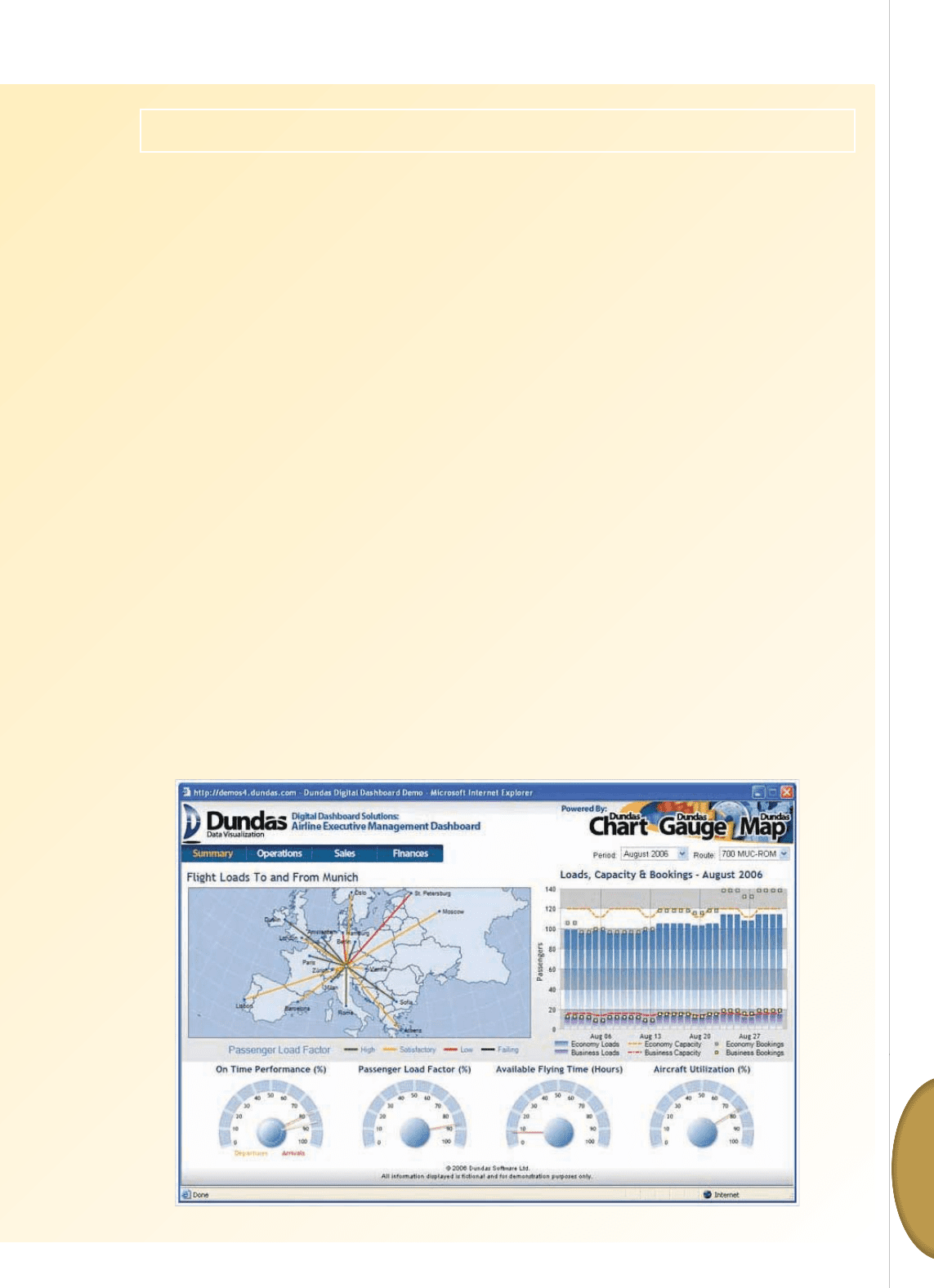
CHAPTER 19 MANAGING THE VALUE CHAIN, INFORMATION TECHNOLOGY, AND E-BUSINESS 583
Controlling
6
It’s rst thing in the morning. You sit down at your
computer, coffee cup in hand, and click on an icon.
Attractively arrayed on the screen is current informa-
tion organized under various headings—for example,
“Calendar,” “Tasks,” “Key Performance Indicators,”
“Sales by Manager,” and those always eye-catching
“Alerts.” Critical information about your business is
presented in colorful tables, pie charts, graphs, and
other visual displays. With just a glance, you’re up-
to-date on everything you need to know before you
start your day. If you’re puzzled by a particular g-
ure or alarmed by an alert, you just click on the item
and start “drilling down” into the data until you get a
detailed picture of exactly what is going on. Welcome
to the world of business performance dashboards.
As impressive as the technology is, it’s the way
organizations design and use dashboards that deter-
mines whether they turn out to be a boon or a dis-
tracting bane. Here are some tips.
▪ Don’t contribute to information overload.
Because dashboards collate information from
many databases and programs, it’s all too easy
to construct a Web page that delivers too much
information. To make dashboards useful, care-
fully choose what data will be tracked and what
information will be displayed. Make sure it’s what
employees need to know to do their jobs better.
▪ Let line managers and employees drive the
development. Always remember that design-
ing a dashboard is primarily a strategic project,
not a technical one. The IT department can help
implement the dashboard, but it is the responsi-
bility of managers to determine its content. One
way to make sure people get the right informa-
tion is to solicit input from end users during the
design process.
▪ Carefully assess who needs a dashboard. At
General Electric, business unit chiefs use dash-
boards, but CEO Jeffrey Immelt rarely does.
Immelt doesn’t want to get so mired in the
details that he loses sight of the big picture. On
the other hand, using dashboards to push infor-
mation farther down into the organization can
help employees at all levels see from day to day
in concrete terms exactly how their actions con-
tribute to an organization’s success or failure in
achieving its goals.
▪ Don’t forget the human touch. Having all the
latest facts and gures at your ngertips is
certainly valuable, but it’s only part of what
managers need to know to run an effective orga-
nization. Getting out and talking to employees
and customers is still just as important.
SOURCES: Spencer E. Ante, “Giving the Boss the Big Picture,”
BusinessWeek (February 13, 2006): 48–51; Tad Leahy, “Warming
Up to Performance Dashboards,” Business-FinanceMag.com
(June 1, 2006), http://business nancemag.com/article/warming-
performance-dashboards-0601; and Doug Bartholomew,
“Gauging Success,” CFO-IT (Summer 2005): 17–19.
Putting Performance Dashboards to Work
Manager’sShoptalk
SOURCE: Dundas Data Visualization, www.dundas.com.
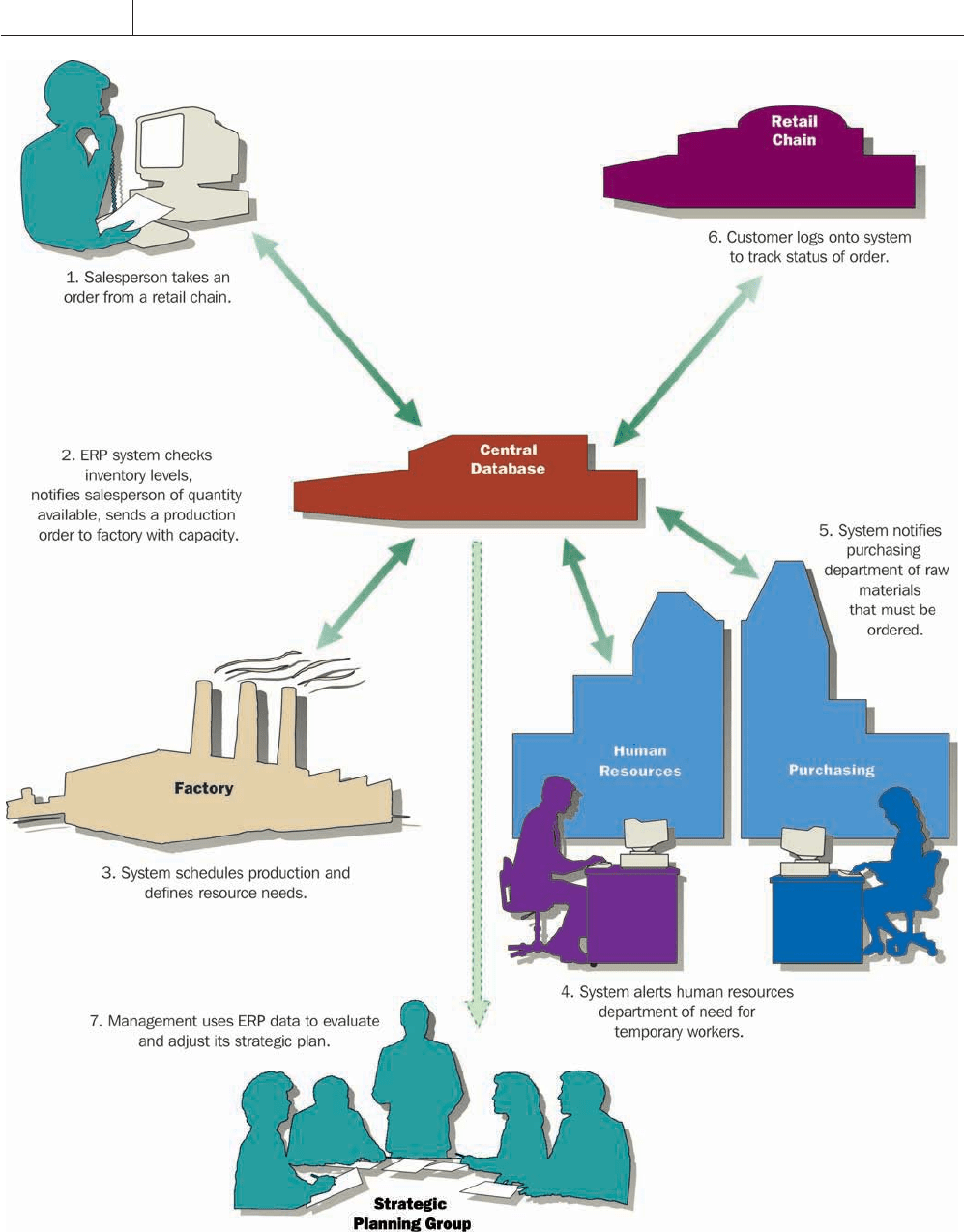
PART 6 CONTROLLING584
EXHIBIT 19.7 Example of ERP Applications
SOURCE: Adapted from Gail Edmondson, “Silicon Valley on the Rhine,” BusinessWeek (November 2, 1997): 162–166.

CHAPTER 19 MANAGING THE VALUE CHAIN, INFORMATION TECHNOLOGY, AND E-BUSINESS 585
Controlling
6
and optimize all the various business processes across the entire rm.
40
A recent study
by AMR Research indicates that the use of ERP continues to grow, with nearly half of
the companies surveyed planning to spend more than $10 million on ERP activities.
The study also showed an increase in the percentage of employees who are using ERP
systems in organizations.
41
An enterprise resource planning system can become the backbone of an organiza-
tion’s operations. It collects, processes, and provides information about an organization’s
entire enterprise, including orders, product design, production, purchasing, inventory,
distribution, human resources, receipt of payments, and forecasting of future demand.
Such a system links these areas of activity into a network, as illustrated in Exhibit 19.7.
When a salesperson takes an order, the ERP system checks to see how the order
affects inventory levels, scheduling, human resources, purchasing, and distribu-
tion. The system replicates organizational processes in software, guides employees
through the processes step by step, and automates as many of them as possible. For
example, the software can automatically cut an accounts payable check as soon as a
clerk con rms that goods have been received in inventory, send an online purchase
order immediately after a manager has authorized a purchase, or schedule produc-
tion at the most appropriate plant after an order is received.
42
In addition, because the
system integrates data about all aspects of operations, managers and employees at all
levels can see how decisions and actions in one part of the organization affect other
parts, using this information to make better decisions. Customers and suppliers are
typically linked into the information exchange as well. When carefully implemented,
ERP can cut costs, shorten cycle time, enhance productivity, and improve relation-
ships with customers and suppliers.
A NEW GENERATION OF INFORMATION
TECHNOLOGY
The force that is fueling growth on the Internet today isn’t a bunch of dot-com start-
ups, or even long-established companies making waves in the online world. Instead,
power has shifted to the individual, with blogs, wikis, and social networking becom-
ing the most explosive outbreaks in the world of information technology since the
emergence of the World Wide Web.
43
A blog is a running
Web log that allows an individual to post opinions and
ideas about anything from the weather and dating relation-
ships to a company’s products, management, or business
practices. An entire industry has sprung up to help manag-
ers navigate the world of blogs, such as monitoring what is
being said about the company, implementing damage con-
trol strategies, and tracking what the majority of the world
is thinking, minute by minute, to help the organization
respond to emerging trends and opportunities.
44
In addi-
tion, managers at companies such as McDonald’s, Marriott
International, and even the once-secretive Boeing are post-
ing blogs of their own to communicate with employees and
customers and present the company’s side of the story to
the public.
45
Companies are also tapping into the power of new IT
applications as powerful collaboration tools within organi-
zations, using group blogs, wikis, social networking, and
peer-to-peer le sharing. The simplicity and informality of
blogs make them an easy and comfortable medium for peo-
ple to communicate and share ideas, both with colleagues
and outsiders. As described earlier, a wiki is similar to a blog
and uses software to create a Web site that allows people to
© BEN BAKER/REDUX
Jeffrey Kalmikoff (left) and Jake
Nichell (right), owners of Threadless, built a $30 million busi-
ness through a social network where users are both customers
and part of the supply chain. Their online T-shirt business uses
Facebook, Twitter, Flickr, MySpace, and the company website to
interact with the Threadless community. Designers submit designs
for T-shirts, and online participants vote for the best designs.
Winners receive a cash prize of $2,500 and reprint fees for designs
that are printed on T-shirts. Threadless has been connecting on-
line with designers since 2000 and opened its fi rst retail location
in Chicago in 2007.
b
b
b
b
b
b
blo
g
Web
Web
lo
lo
t
g
t
g
hat
hat
al
al
low
low
s
i
i
i
d
n
nd
in
i
n
nd
ivi
ivi
d
dua
dua
l
ls
ls
to
to
pos
pos
to
t
o
pin
pin
ion
ion
s
s
a
a
a
a
an
an
an
nd
i
d
eas
.

PART 6 CONTROLLING586
create, share, and edit content through a browser-based interface. Rather than simply
sharing opinions and ideas as with a blog, wikis are free-form, allowing people to
edit what they nd on the site and add content.
46
The best-known example of a wiki is
the online encyclopedia Wikipedia, where thousands of volunteer contributors have
written, edited, and policed more than 9 million entries in more than a hundred lan-
guages.
47
Boeing and BMW both use wiki software to open much of their design work
to partner organizations.
Social networking, also referred to as social media or user-generated content, is an
extension of blogs and wikis.
48
Sites such as MySpace, Facebook, and Friendster pro-
vide an unprecedented peer-to-peer communication channel, where people interact
in an online community, sharing personal data and photos, producing and sharing
all sorts of information and opinions, or unifying activists and raising funds. Smart
companies are nding ways to bene t from the phenomenon. Work networks on
Facebook and MySpace are exploding, and some companies, including Dow Chemi-
cal, JPMorgan Chase, and Lockheed Martin, are starting their own in-house social
networks as a way to facilitate information sharing.
49
As a new manager, incorporate new IT tools to extend the power of your organization’s
management information systems. Recognize that people need different tools,
depending on their work as well as how they like to process and use information.
Peer-to-peer le sharing, such as that pioneered by Napster for sharing music
online, enables PCs to communicate directly with one another over the Internet,
bypassing central databases, servers, control points, and Web pages.
50
Peer-to-peer
software lets any individual’s computer “talk” directly to another PC without an
intermediary, enhancing the opportunities for information sharing and collaboration.
Peer-to-peer technology improves ef ciency by eliminating the need for setting up
and managing huge central storage systems. GlaxoSmithKline uses P2P technology
to let its employees and researchers outside the company share their drug test data
digitally and work collaboratively on new projects. Law rm Baker & McKenzie uses
it to allow major clients to tap directly into its attorneys’ les stored on computers
worldwide.
51
THE INTERNET AND E-BUSINESS
In recent years, most organizations have incorporated the Internet as part of their
information technology strategy.
52
Both business and nonpro t organizations
quickly realized the potential of the Internet for expanding their operations globally,
improving business processes, reaching new customers, and making the most of
their resources. Exhibit 19.8 shows the popular iPod nano, one of the many products
that Apple sells over the Internet and in retail stores.
Numerous organizations today are involved in some type of e-business. E-business
can be de ned as any business that takes place by digital processes over a computer
network rather than in physical space. Most commonly today, it refers to electronic
linkages over the Internet with customers, partners, suppliers, employees, or other
key constituents. E-commerce is a more limited term that refers speci cally to busi-
ness exchanges or transactions that occur electronically.
Some organizations, such as eBay, Amazon.com, Expedia, and Yahoo! would not
exist without the Internet. However, most traditional, established organizations,
including General Electric; the City of Madison, Wisconsin; Macy’s; and the U.S.
Postal Service, also make extensive use of the Internet, and we will focus on these
types of organizations in the remainder of this section.
TakeaMoment
s
s
s
s
s
soc
ial networkin
g
O
n
l
ine
i
i
in
n
n
teract
i
on
i
n a commun
i
t
y
f
f
f
f
fo
o
r
f
f
f
mat where
p
eo
p
le share
p
er
-
-
-
s
s
s
s
so
on
s
o
on
al
al
inf
inf
orm
orm
ati
ati
on
on
and
and
ph
ph
oto
oto
s,
s,
p
p
p
p
p
ro
d
d
uce a
d
n
d
h
s
h
are
ll
a
ll
sorts
f
o
f
i
i
in
n
n
n
formation and opinions, or
u
u
u
u
u
ni
fy
activists an
d
raise
f
un
d
s.
p
p
p
p
p
eer-to-peer fi le sharing
F
F
F
F
Fi
i
le sharin
g
that allows PCs
t
t
t
o
o
communicate directl
y
with
o
o
o
o
o
ne another over the Internet
,
b
b
b
b
by
y
passin
g
centra
l
d
ata
b
ases,
s
s
s
s
se
e
rvers, contro
l
points, an
d
We
b
b
b
b
b
p
p
p
p
p
ages
.
e
e
e
e
-
b
us
in
ess
An
y
business tha
t
t
t
t
t
a
a
kes place b
y
di
g
ital processe
s
s
o
o
o
o
ov
v
er a computer networ
k
rat
he
er
r
r
r
t
t
t
h
h
h
an in p
h
ysica
l
space.
e
e
e
e
-
c
ommerce
Bus
in
ess
e
x
-
c
c
c
c
ch
h
an
g
es or transactions that occ
u
u
r
r
r
r
e
e
e
e
el
l
ectronicall
y.
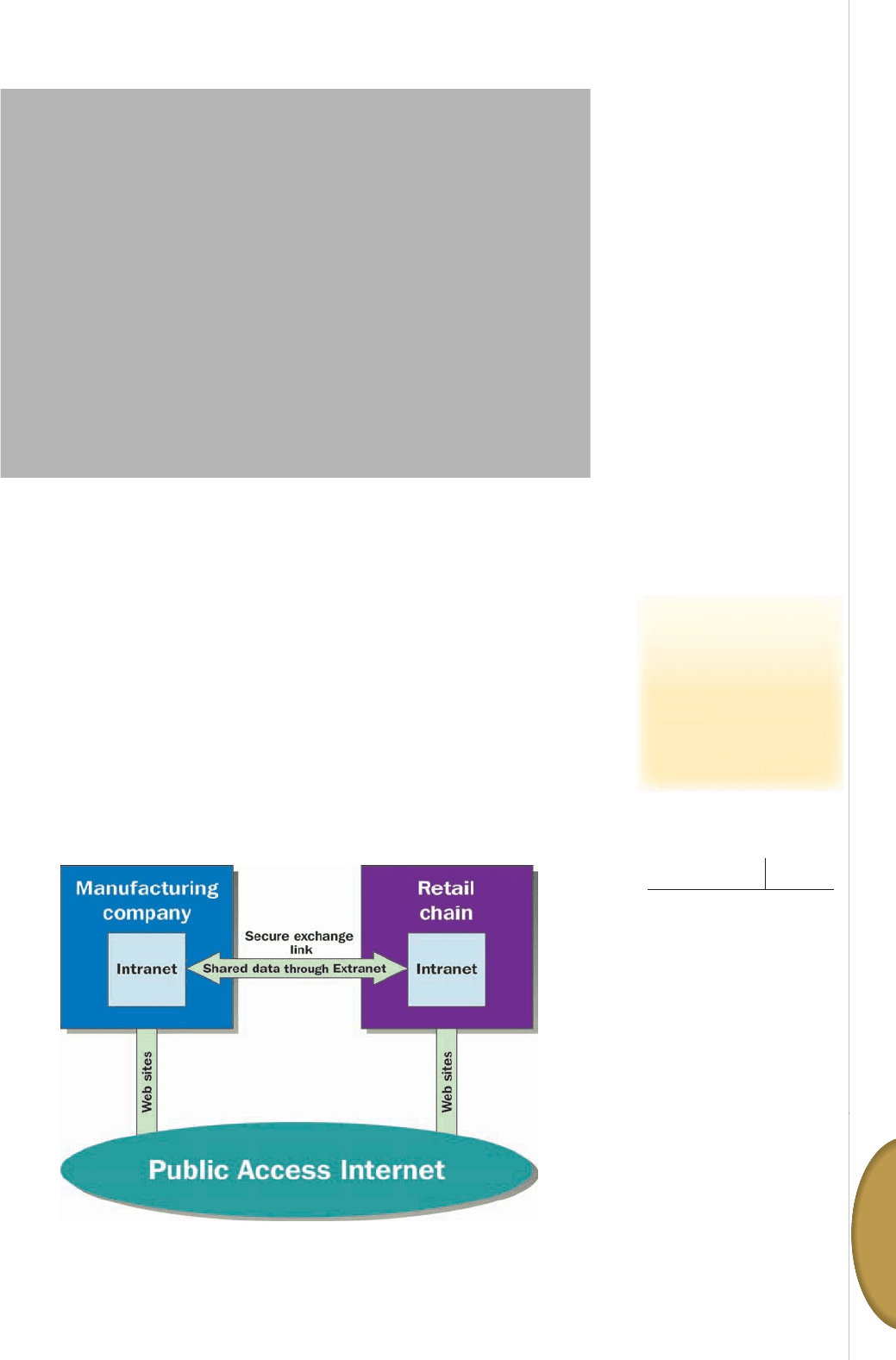
CHAPTER 19 MANAGING THE VALUE CHAIN, INFORMATION TECHNOLOGY, AND E-BUSINESS 587
Controlling
6
EXHIBIT 19.9
The Key Components of
E-Business for Two Tradi-
tional Organizations
SOURCE: Based on Jim Turcotte, Bob Silveri, and Tom Jobson, “Are You Ready for the E-Supply
Chain?” APICS—The Performance Advantage (August 1998): 56–59.
Exhibit 19.9 illustrates the key components of e-business for two organizations,
a manufacturing company and a retail chain. First, each organization operates an
intranet, an internal communications system that uses the technology and standards
of the Internet but is accessible only to people within the company. The next com-
ponent is a system that allows the separate companies to share data and informa-
tion. An extranet is an external communications system that uses the Internet and
is shared by two or more organizations. With an extranet, each organization moves
certain data outside of its private intranet, but makes the data available only to the
other companies sharing the extranet. The nal piece of the overall system is the
Internet, which is accessible to the general public. Organizations make some informa-
tion available to the public through their Web sites, which may include products or
services offered for sale.
i
i
i
i
in
in
int
r
a
n
et
A
n in
t
e
rn
a
l
co
m
mu-
-
n
n
n
n
n
ications s
y
stem that uses the
t
t
t
e
e
e
c
t
t
h
h
no
l
l
o
g
y
a
d
n
d
sta
d
n
d
a
d
r
d
s
f
o
f
h
t
h
e
e
e
e
e
e
I
I
I
n
n
n
t
I
I
ernet
b
b
ut
i
i
s acces
ib
s
ib
l
l
e
l
on
l
y
t
o
o
o
o
o
o
o
p
p
p
p
eo
p
p
eo
ple
ple
wi
wi
thi
thi
nt
n
t
he
he
org
org
ani
ani
zat
zat
ion
ion
.
.
e
e
e
e
e
x
t
r
a
n
et
A
n
e
x
t
e
rn
a
l
co
mm
u-
-
-
-
n
n
n
n
n
n
ications s
y
stem that uses the
I
I
I
n
n
n
ternet and is shared b
y
two
o
or
r
r
r
r
m
m
m
m
m
m
mo
mor
m
e or
g
a
g
nizations.
Image not available due to copyright restrictions
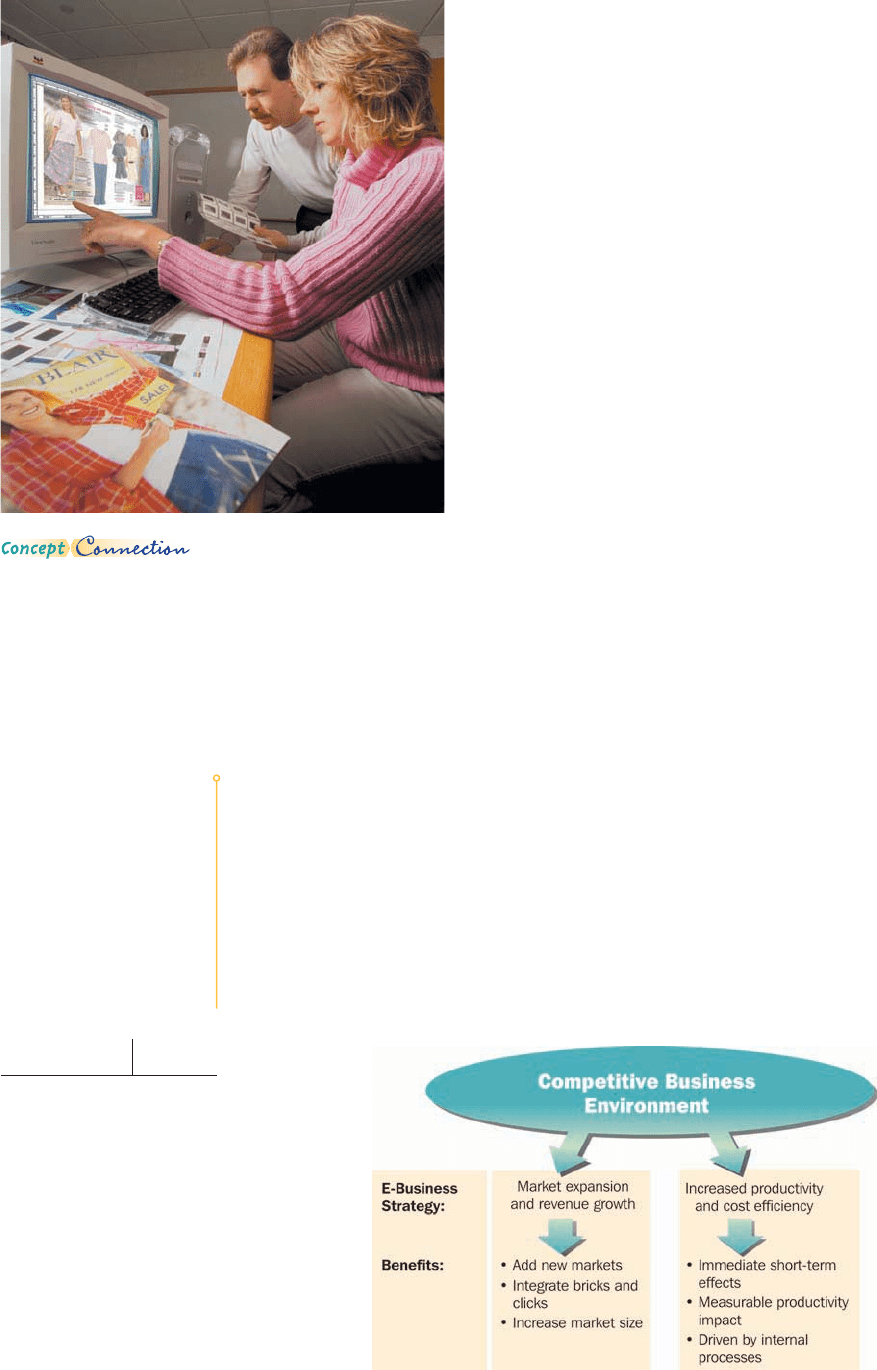
PART 6 CONTROLLING588
The first step toward a successful e-business for an
established firm is for managers to determine why they
need such a business to begin with.
53
Failure to align the
e-business initiative with corporate strategy can lead to
e-business failure. Two basic strategic approaches for
traditional organizations setting up an Internet opera-
tion are illustrated in Exhibit 19.10. Some companies
embrace e-business primarily to expand into new mar-
kets and reach new customers. Others use e-business as
a route to increased productivity and cost efficiency.
E-Business Strategy: Market Expansion
An Internet division allows a company to establish direct
links to customers and expand into new markets. The
organization can provide access around the clock to a
worldwide market. ESPN.com, for example, is the biggest
Internet draw for sports, attracting a devoted audience of
18- to 34-year-old men, an audience that is less and less
interested in traditional television. The site’s ESPN360,
a customizable high-speed service, offers super-sharp
video clips of everything from SportsCenter to poker tour-
naments, as well as behind-the-scenes coverage. To reach
young viewers, other television networks, including Com-
edy Central, E. W. Scripps Networks, which owns HGTV
and the Food Network, CBS Broadcasting, and NBC Uni-
versal, have also launched high-speed broadband channels
to deliver short videos, pilots of new shows, or abbreviated
and behind-the-scenes looks.
54
Retailers have also been big
winners with a market expansion strategy. JCPenney was one of the rst traditional
retailers to launch a Web site.
Not so long ago, the century-old JCPenney department store chain had so many troubles that
some analysts predicted it wouldn’t survive. Today, however, the retailer is thriving, thanks in
part to managers’ mastery of e-business.
Penney was one of the fi rst traditional retailers to launch a Web site in 1994. Though that
initial site sold only one product—Power Rangers—it gave the company invaluable experience
for expansion once the Internet really took off. Today, Penney has one of the most productive
online stores among mainstream retailers. The Web site has enabled the company to attract
a younger customer base than those who typically shop at Penney and fi nd ways to lure them
into bricks-and-mortar stores. Penney embraced the Internet wholeheartedly, encouraging
cooperation between its Web site and stores from the beginning. It was the one of the fi rst
JCPenney
Innovative Way
EXHIBIT 19.10
Strategies for Engaging
Clicks with Bricks
© BLAIR CORPORATION
Blair Corporation is a multichannel
direct marketer of apparel and home merchandise for value-conscious
customers. In 2003, Blair launched an Internet division aimed at
market expansion. Using a variety of tools and techniques, including
virtual catalogs, Blair.com added 170,000 new-to-fi le customers in
its fi rst year, with an average age nearly 15 years younger than their
traditional core customers: “proof of the power of this new channel.”

CHAPTER 19 MANAGING THE VALUE CHAIN, INFORMATION TECHNOLOGY, AND E-BUSINESS 589
Controlling
6
to allow customers to pick up and return items bought online at their local store, and it was
the fi rst to give online shoppers a way to check which clothes are in stock at local stores. It’s
no wonder Penney’s ranks among the top fi ve Web sites in terms of the number of paying
customers it attracts.
55
Like JCPenney, most retailers selling products online also now use their Web sites
to drive more traf c into stores. Bloomingdale’s tapped into the social networking
phenomenon by sponsoring a three-day event that allowed people to try on out ts
in front of an interactive mirror that connected them to their friends via the Inter-
net. Most other big retailers also now let online shoppers pick up purchases at the
local store. Circuit City promises that online purchases will be ready for pickup in
24 minutes—if they’re not, the customer gets a $24 gift card. Getting people to the
store gives staff a chance to push accessory items and increase sales.
56
Go to the ethical dilemma on page 591 that pertains to using the Internet for market
expansion.
E-Business Strategy: Increasing Effi ciency
With this approach, the e-business initiative is seen primarily as a way to improve
the bottom line by increasing productivity and cutting costs. Automakers such as
Toyota, General Motors, and Ford, for example, use e-business to reduce the cost
of ordering and tracking parts and supplies and to implement just-in-time manu-
facturing. At Nibco, a manufacturer of piping products, 12 plants and distribution
centers automatically share data on inventory and orders via the Internet, resulting
in about 70 percent of orders being automated. The technology has helped Nibco
trim its inventory by 13 percent, as well as respond more quickly to changes in orders
from customers.
57
Several studies attest to real and signi cant gains in productivity from e-business.
58
Even the smallest companies can realize gains. Rather than purchasing parts from a
local supplier at premium rates, a small rm can access a worldwide market and nd
the best price, or negotiate better terms with the local supplier.
59
Service rms and
government agencies can bene t too. New York City became the rst city to use the
Internet to settle personal injury claims more ef ciently. Using NYC Comptroller’s
Cybersettle Service, lawyers submit blind offers until a match is hit. If an agreement
can’t be reached, the parties go back to face-to-face negotiations. The city saved $17
million in less than two years by settling 1,137 out of 7,000 claims online and reduced
settlement times from four years to nine months.
60
TakeaMoment
ch19
A MANAGER’S ESSENTIALS: WHAT HAVE WE LEARNED?
▪ This chapter described several points about operations management and the use
of information for management and control. Operations management pertains to
the tools and techniques used to manage the organization’s core production pro-
cess. These techniques apply to both manufacturing and service organizations.
▪ Supply chain management is a crucial area for operations, and today’s managers
use Internet and computer-based technology to manage the sequence of suppli-
ers and purchasers covering all stages of processing from obtaining raw materi-
als to distributing nished goods to consumers. Other important considerations
for operations management include facilities layout and technology automation,
including RFID, exible manufacturing systems, and lean manufacturing. The
chapter also discussed inventory management. Three types of inventory are raw
